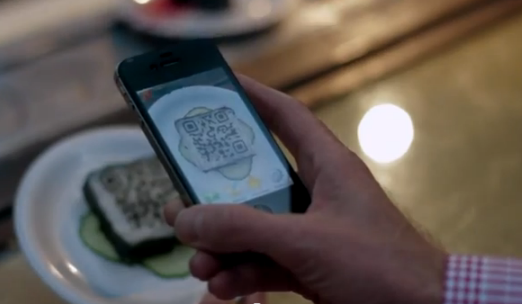I have always been fascinated by the potential of quick-response codes to revolutionize the marketing arena. In fact I’d be willing to hazard a guess that these marketing marvels will continue to reshape the way that individuals and companies promote their brand. In my capacity as the co-founder and CMO of a QR codes company, I’ve had the opportunity to work alongside the brightest in the business. We’ve seen dramatic strides with QR codes -from mundane black and white squares to visual QR codes. In the days of old (the lingua franca for anything older than 5 years in the tech world) the codes were hardly enticing as marketing resources. While their potential has always been highly regarded, it’s almost as if the connection between a QR code and its marketing message was lost. Well, I believe that we have stumbled upon the Holy Grail of QR codes; the veritable message in bottle that has changed the way that customers, patrons, passersby and everyday folks can interact with these precious gems. It’s not so much what QR codes do as much as it is presenting them in a way that they are hitting their targets. And in the marketing world, everything is measurable. We use all sorts of yardsticks to evaluate the effectiveness of QR code marketing campaigns.
The Food Industry In Japan
 Asia is a hotbed of activity for QR code marketing campaigns. As a matter of fact it was a subsidiary of Toyota (Denso Wave) that first used QR Codes in 1994. In the years since, these QR codes have been adopted across multiple industries. One of the most active industries is the food and beverage industry of Japan. Numerous examples of successful QR code marketing campaigns abound. For the purposes of illustration, we can highlight the use of QR codes and sushi. As a delicacy and a staple across the island nations of Japan, QR codes are widely used to provide more information on these mouth-watering appetizers. In a tech-crazy nation of sushi consumers, the use of QR codes provides big incentives to promote marketing messages. Since the sushi is going to be consumed, itâs highly likely that patrons will scan the codes and be taken backstage to the kitchen, or to the fisheries, to see how master chefs prepare the food. All sorts of promotional messages are punted with brand awareness winning through. Scans of food-related QR codes across Asia are high and the ‘participatory experience’ certainly adds value to the marketing messages. But how do we evaluate the aforementioned effectiveness? How do we know which strategies will work?
Asia is a hotbed of activity for QR code marketing campaigns. As a matter of fact it was a subsidiary of Toyota (Denso Wave) that first used QR Codes in 1994. In the years since, these QR codes have been adopted across multiple industries. One of the most active industries is the food and beverage industry of Japan. Numerous examples of successful QR code marketing campaigns abound. For the purposes of illustration, we can highlight the use of QR codes and sushi. As a delicacy and a staple across the island nations of Japan, QR codes are widely used to provide more information on these mouth-watering appetizers. In a tech-crazy nation of sushi consumers, the use of QR codes provides big incentives to promote marketing messages. Since the sushi is going to be consumed, itâs highly likely that patrons will scan the codes and be taken backstage to the kitchen, or to the fisheries, to see how master chefs prepare the food. All sorts of promotional messages are punted with brand awareness winning through. Scans of food-related QR codes across Asia are high and the ‘participatory experience’ certainly adds value to the marketing messages. But how do we evaluate the aforementioned effectiveness? How do we know which strategies will work?
Without further ado, let’s turn our attention to the Top 5 QR code marketing tactics for businesses and websites.
5 Steps To Effective QR Code Marketing Strategies
- The first step in the process is planning. As with any marketing strategy, it is important to understand precisely who your target market is and what goals you’re looking to achieve. Your objective should be quantifiable, based on the efforts that you have expended in putting the marketing campaign together. Be sure that your audience understands how to scan QR codes. You may want to try using e-mail lists, Facebook, blogs and other social media channels too. Incentivise your QR code marketing campaign by way of demos, free e-books, coupons, contests, free MP3s, VIP access and so forth. As you build more brand awareness, credibility and popularity among customers, passersby and the general public, so the likelihood that your QR codes will be scanned is that much greater.
- Now that you’ve established a base of operations, it’s imperative that the QR codes you’re using are fully functional and reliable. In this vein, quality QR codes should be generated, and their effectiveness should be tested. Of course, this all depends on your particular audience. Tailoring QR codes to audience expectations is always a good idea, and visual QR codes have been shown to increase return on investment (ROI) over traditional black-and-white QR codes. Try to avoid clutter in your marketing messages on posters, websites will business cards â QR codes have exponential marketing power so they don’t need all the noise around them. And remember that QR codes should only be used where Internet connections are available and where they can be scanned. Subways, tunnels, or zones where wireless Internet is unavailable are simply no-goes. QR codes that are too far away to be scanned are simply a waste of time and energy.
- Now that you’ve got your strategy in place and you’ve got a fully functional QR code, you will need to link your code to smartphone friendly site. Be sure that the sites are fully optimised for iOS devices, Android devices and feature Flash functionality too. Of course, it is better if your site is mobile optimised for smartphone access as this will make it possible for users to enjoy all the features that you want them to see. Your site should have action oriented phrases (calls to action), incentives, visually appealing videos/images/symbols and so forth. Some of the most popular features for mobile optimised websites include links to social media sites, Google maps integration, and tap to call/e-mail/SMS links.
- With all of the aforementioned strategy in place you will no doubt want to be able to track the effectiveness of your QR code marketing campaign. Not only will you want to know how many scans have resulted, but you may want to know about the users in question. QR code management systems abound, and lots of data can be gleaned from using such systems to better prepare your marketing messages for specific audiences.
- The last phase in any strategic planning message is the control phase. This is the point in the process where you evaluate the results against the objectives. What was achieved versus what did you want achieved? How can you improve upon the results given the information that you have, with information that you don’t have? Use all of the data that you have collected to enhance your QR codes marketing strategy.
A prime example of a successful QR codes marketing strategy in action is when Tesco (Home Plus) came to South Korea. They couldn’t compete with the leading brand in terms of number of stores, so they put up posters and virtual stores in subways across the country. The result was a massive spike in popularity for the brand and a #2 ranking in South Korea overall. This is the result of a successful QR code marketing strategy â much the same as the 5 points listed above. By following a sound marketing strategy, your QR code campaign can be tailored to your audience, entice them to scan and participate, and boost your return on investment. This marketing marvel is still in its infancy stages, but all signs are encouraging for terrific results in the present, and the future!

1 Comment
Leave a Reply
Cancel reply
Leave a Reply
This site uses Akismet to reduce spam. Learn how your comment data is processed.























































































































































































Gautam
October 4, 2013 at 8:34 pm
great post In QR codes but i think it would have been More better and please write posts in good manner it is looking like essay by an 5 Year child.